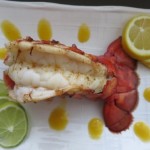Baked Lobster with Mango Sauce
This is one of my favorite meals to prepare for a special celebration. Not only is it oh so special and delicious, it’s pretty easy to prepare. It can be intimidating . But if you follow a few guidelines, you’ll be able to prepare an elegant meal. You’re going to be able to make this meal and not spend the day or a good part of the evening cooking. The Mango Sauce is optional.
Ingredients
Clarified butter
- 2 sticks Butter 1/2 lb
Garlic Lemon Butter ( for two lobster tails)
- 1/4 cup Clarified Butter
- 1/4 tsp paprika
- 1 clove garlic , minced
- 1 tsp Lemon Juice , fresh
- 1/2 tsp salt
- 1/2 tsp white pepper
Mango Sauce
- 1 mango , peeled and diced
- 1 tbsp sugar
- 2 tbsp + 1 tsp Lemon Juice , fresh, (approximately 1/2 a lemon)
- 1 1/2 tbsp Lime Juice , fresh, (approximately 1/2 a lime)
Instructions
Buying the Ideal Lobster
- There are cold water (Gulf of Maine) lobsters and there are warm water ( Florida, Caribbean & Southern California) lobsters. The cold water lobsters will have whiter meat and a sweeter flavor. They grow slowly in the cold northern water making their meat very tender.
- Lobster tails range in size, 4 oz to 24 oz. The smaller the tail, the more flavor it has. So avoid those mega size lobster tails. You’ll need about 24 hours to thaw the tails in your refrigerator. If you need to speed the timeing, thawing the tails in a bowl or sink of cold water will hasten the process.
Clarified Butter Info
- Clarified butter (a.k.a. drawn butter) is ideal for lobster tails because it has a less greasy taste and can handle heat as high as 400-500 degrees without burning. It may seem intimidating to create, but it’s not. It’s simply melting butter on a low heat until the water content has evaporated and the milk solids have separated. The end result is clear butter fat. It is actually the milk solids that have burned in burnt butter. If you are using a butter warmer when serving your lobster, clarified butter won’t spit and possibly burn you or your table. It is good for months if kept in an air tight container in your refrigerator.
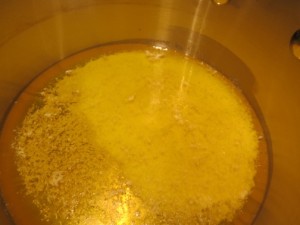
- Just like cold water versus warm water lobster tails, the butter also makes a difference. This isn’t the time to use just any butter. European and European Style butters have a higher fat content , more fat to water than most large commercial brands. The higher fat content gives you a creamier buttery flavor. Just like wines, cheese and olive oils, they pick up flavors from their terrior. Where cows live and what they eat does affect the flavor of butters. If you want to avoid this step, there are prepackaged clarified butter available at some markets. Or, if you use unclarified butter, it won’t ruin your meal. It will still be outstanding!
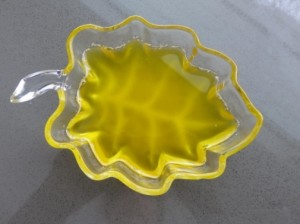
Clarified Butter
- Over low heat, melt the butter until it is foaming. With a spoon, skim off the foam and save in an air tight container. Gently pour the clarified butter into another air tight container, leaving the milk solids in the bottom of the sauce pan. Save the foam and milk solids, you can reuse these. Use them to baste chicken and vegetables, add to mashed potatoes and cream sauces.
- *When clarifying butter, you’ll lose about a quarter to a third of the butter in foam & milk solids. This recipe will be enough to create the Garlic Lemon Butter. If you want some extra butter for dipping your lobster meat, make a little more clarified butter.
Prepping Your Lobster Tails
- You’ll know your tails are completely thawed when you can bend the tail from end to end. You don’t want to cook a partially frozen tail. That’s how you can get tough lobster meat. It will take longer to cook a frozen part of the tail, making the thawed outer edgesYou’ll need a sharp kitchen scissors. Cut the center of the back of the lobster tail down to the fin without cutting into the fin. With your fingers, starting just before the fin, detach the lobster meat from sides and bottom of the shell. You will crack the shell on the bottom some but no will know. Spreading the shell open a little farther, pull the meat out of the shell but still keeping it attached at the fin. Lay the lobster meat gently on top of the shell. The shell in going to act as a rack for cooking your lobster. over cooked and tough.
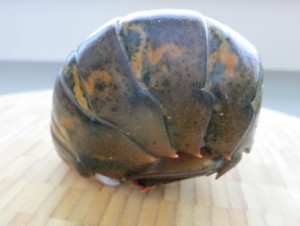
- You’ll need a sharp kitchen scissors. Cut the center of the back of the lobster tail down to the fin without cutting into the fin. With your fingers, starting just before the fin, detach the lobster meat from sides and bottom of the shell. You will crack the shell on the bottom some but no will know. Spreading the shell open a little farther, pull the meat out of the shell but still keeping it attached at the fin. Lay the lobster meat gently on top of the shell. The shell in going to act as a rack for cooking your lobster.
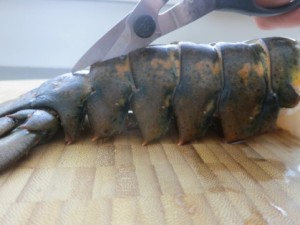
Cooking Your Lobster Tails
- Your lobster tails will need to be at room temperature. Rule of thumb is 1 ½ minutes of cooking time for every ounce of lobster. If you have 10 ounce lobster tails, they will need to cook for 15 minutes. Preheat oven to 350 degrees. Place the lobster tails on a baking sheet. Add a small amount of water to the baking sheet. This will help the tails steam during cooking, keeping them moist. Baste the lobster tails with the Garlic Lemon Butter. Baste again half way through the cooking time. The tails should reach an internal temperature of 140 degrees. Remove lobster from the oven. Turn the oven on broil. Baste the tails for a third time. Place tails under the broiler for just a couple minutes or until very lightly golden.
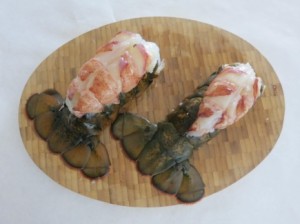
Other Seasoning Ideas
- You can have lots of fun with creating a butter to your liking. Eliminate the garlic and have a simply elegant Lemon Butter. Or, add your favorite seasonings or herbs: Cajun seasoning, seafood seasoning, fresh chopped tarragon, dill or parsley.
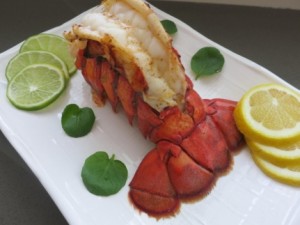
- Now you’re ready! You can make your clarified butter, butter marinade and mango sauce ahead of time. Pull your prepped lobster tails out of the refrigerator. Warm your butter marinade. All that’s left to do is baste and cook.


